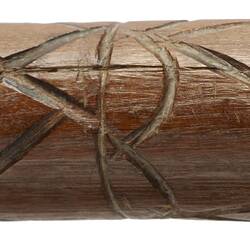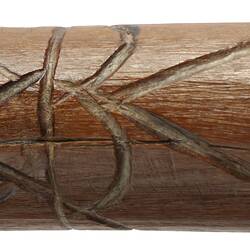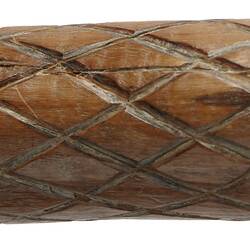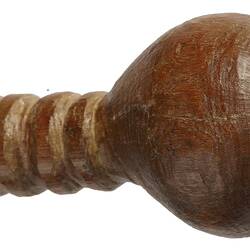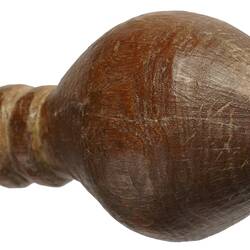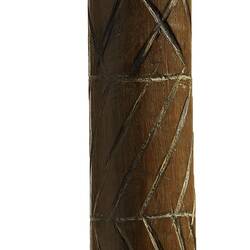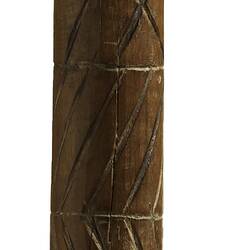Summary
'Yam Daisy roots were collected in bowls made of eucalyptus bark,' explains Wurundjeri Elder Aunty Alice Kolasa. 'All Wurundjeri-Willam women carried a long, fire-hardened digging stick made from wattle wood, known as a kannan, to dig up the root or tuber of the Murnong, thus turning over the soil and thinning out the root clumps, two ways of encouraging plant production. Aboriginal people believed that the roots of the Murnong should not be collected before the plants flowered. During the drier winter period before springtime flowering, the roots would not be fully developed.'
To Aboriginal groups in Victoria, the root of the Murnong (Yam Daisy) was a favoured and a vital food staple. Pre-contact it grew quite abundantly in the south-west and around Port Phillip.
Local Name
Kannan
Physical Description
Digging stick has a large and bulbous proximal end and a cylindrical shaft which tapers to a wedge shaped point at the digging end. The shaft is decorated with grooved symmetrical designs of curved and straight lines. The handgrip has large grooves around shaft and the bulb has been lightly roughened.
Significance
At the time of colonisation, the harvesting of roots for food on plains in Victoria by Aboriginal people was extensive. Records of early observers indicate that a widespread custom for traditional custodians in southern Australia was to replant some pieces of foodplants. This would have ensured ongoing availability of these species.
Colonisation had a devastating effect on the local ecology, with sheep and cattle grazing causing the demise of this yellow-flowered perennial herb. Today, the Murnong is becoming re-established through the concentrated efforts of community programs such as those run by the Merri Creek Management Committee, which holds annual harvest and cook-up picnics that also feature Aboriginal dancers and activities.
More Information
-
Object/Medium
Digging implement
-
Maker
-
Locality
-
Date Produced
-
Collector
-
Object Measurements
880 mm (Length), 70 mm (Width), 70 mm (Height)
-
Classification
-
Date Made
-
Maker
-
Clan/Language Group
-
Place Made
-
Indigenous Region
-
Keywords
-
Collection Names
-
Type of item
-
Discipline
-
Category
-
Collecting Areas

